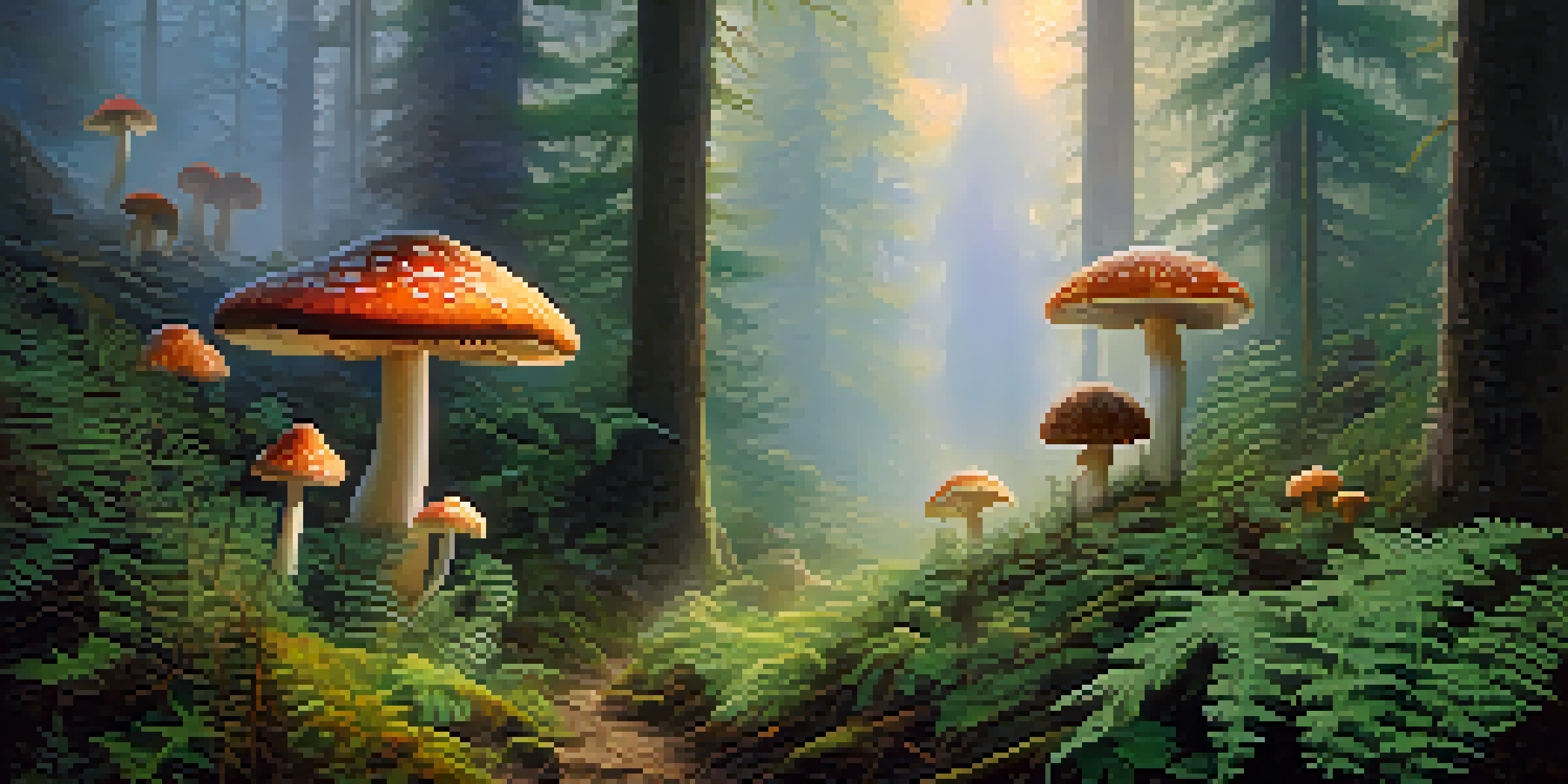The Role of Entheogens in Non-Dual Awareness Experiences

Understanding Entheogens and Their Effects
Entheogens are substances that can induce altered states of consciousness, often used in spiritual or shamanic practices. Common examples include psilocybin mushrooms, ayahuasca, and peyote, each offering unique experiences that can lead to profound insights. These substances have been utilized for centuries in various cultures for their ability to facilitate connection with the divine or the self.
The greatest discovery of my generation is that a human being can alter his life by altering his attitude.
When consumed, entheogens can dissolve the boundaries of the ego, allowing individuals to experience a sense of unity with the universe. This dissolution of self can lead to moments of clarity where one perceives life from a broader, more interconnected perspective. As a result, users often report experiencing feelings of love, peace, and a deep understanding of existence.
However, it's essential to approach entheogens with caution and respect, as their effects can vary widely based on individual mindset and environment. A supportive setting, often referred to as 'set and setting,' plays a crucial role in shaping the experience. Understanding these elements can help individuals maximize the benefits while minimizing potential risks.
Non-Dual Awareness: What It Is and Why It Matters
Non-dual awareness refers to a state of consciousness where the distinction between self and other dissolves. In this state, individuals may feel that they are part of a larger whole, transcending the usual boundaries that define individual existence. This experience can lead to profound insights and a greater sense of connectedness with everything around them.

Many spiritual traditions emphasize the importance of non-dual awareness as a way to achieve enlightenment or liberation from suffering. By recognizing the illusory nature of separation, individuals can cultivate a deeper sense of compassion and understanding for themselves and others. This shift in perspective can be transformative, promoting emotional healing and personal growth.
Entheogens Induce Altered States
Entheogens, like psilocybin and ayahuasca, can facilitate profound experiences that promote non-dual awareness and interconnectedness.
Engaging with non-dual awareness is often seen as a pathway to achieving inner peace and fulfillment. Practices such as meditation, mindfulness, and even certain forms of psychotherapy can facilitate this experience. Thus, exploring non-dual awareness can be beneficial for anyone seeking a richer, more meaningful life.
The Connection Between Entheogens and Non-Dual Awareness
Research and anecdotal evidence suggest a strong link between entheogens and the experience of non-dual awareness. Many users report that these substances can induce states where the sense of individual self fades away, allowing for a profound connection with the universe. This shared experience across various cultures points to a universal aspect of human consciousness.
We are not human beings having a spiritual experience; we are spiritual beings having a human experience.
For instance, ayahuasca ceremonies often lead participants to experience deep, non-dual insights about their lives and the world around them. These moments can foster a sense of oneness, compassion, and understanding that may not be as accessible in ordinary states of consciousness. The power of entheogens lies in their ability to catalyze these transformative experiences.
Yet, while entheogens can facilitate non-dual awareness, they are not a substitute for consistent inner work and practice. Many individuals find that integrating these experiences into their daily lives requires ongoing effort and reflection. The combination of entheogenic experiences and mindfulness practices can create a holistic approach to exploring non-dual awareness.
Cultural Perspectives on Entheogens and Non-Duality
Throughout history, various cultures have utilized entheogens in their spiritual practices, often with a focus on achieving non-dual awareness. Indigenous communities, for instance, have long used these substances in rituals aimed at connecting with nature and the spirit world. This traditional knowledge emphasizes the importance of community and shared experiences in understanding existence.
In contemporary society, there is a growing interest in these ancient practices, as more individuals seek alternative paths to personal and spiritual growth. Events like music festivals and retreats often incorporate entheogenic experiences, creating spaces for communal exploration of consciousness. This cultural shift highlights a renewed appreciation for the wisdom of ancient traditions.
Cultural Context Matters
Respecting the cultural origins and practices surrounding entheogens is crucial for meaningful and responsible engagement with these substances.
Understanding these cultural contexts can enhance our appreciation for the role of entheogens in non-dual awareness. By respecting and learning from these practices, we can approach our own experiences with humility and openness. This cultural perspective can also inspire a more responsible and conscious use of entheogens in modern contexts.
Potential Risks and Ethical Considerations
While entheogens can offer profound insights, they also come with potential risks that should not be overlooked. Some individuals may experience anxiety, confusion, or even psychological distress during or after their experiences. It’s crucial for anyone considering the use of entheogens to be aware of their mental health history and the setting in which they choose to engage with these substances.
Ethical considerations also arise when discussing entheogens, particularly regarding cultural appropriation and the commercialization of sacred practices. It’s important to honor the traditions from which these substances originate and approach their use with respect for the cultures that have historically utilized them. Engaging with these practices should be done thoughtfully and with an understanding of their significance.
Ultimately, a mindful and informed approach to entheogens can help mitigate risks while maximizing the potential for meaningful experiences. Seeking guidance from experienced practitioners and participating in supportive environments can further enhance safety and efficacy. By acknowledging these complexities, we can navigate the landscape of entheogens with greater awareness.
Integrating Non-Dual Experiences into Daily Life
After experiencing non-dual awareness through entheogens, many individuals face the challenge of integrating these insights into their everyday lives. The sense of oneness and interconnectedness can feel elusive once the effects of the substance wane. However, there are various practices that can help maintain this awareness, such as meditation, journaling, or mindful breathing.
Creating a regular practice of reflection can deepen one’s understanding and appreciation of these experiences. For example, keeping a journal to document feelings, insights, and shifts in perspective can facilitate ongoing growth and awareness. Engaging with supportive communities can also provide encouragement and shared understanding during this integration process.
Integration is Key to Benefits
Successfully integrating non-dual experiences into daily life through practices like meditation and mindfulness can enhance personal growth and well-being.
Moreover, incorporating mindfulness into daily activities can help anchor non-dual awareness in everyday life. Simple acts like paying attention to nature, practicing gratitude, or being present in conversations can reinforce the connections felt during entheogenic experiences. This approach fosters a more profound sense of peace and interconnectedness in one’s life.
The Future of Entheogens and Non-Dual Awareness Research
As interest in entheogens and their potential benefits grows, so does the importance of research into their effects on non-dual awareness. Scientists and psychologists are increasingly studying how these substances can promote healing and understanding within various therapeutic contexts. This research could pave the way for greater acceptance of entheogens in mainstream mental health practices.
Current studies are exploring the neurobiological mechanisms behind the experiences induced by entheogens, shedding light on why they can lead to non-dual awareness. This scientific exploration not only validates anecdotal reports but also broadens our understanding of consciousness itself. As we learn more, we may discover new applications for these substances in supporting mental and emotional well-being.

In the future, we may see a more integrated approach to entheogens and spirituality within psychology and wellness industries. This could lead to innovative therapies that utilize non-dual awareness as a pathway to healing trauma and fostering personal growth. Ultimately, the ongoing exploration of these connections holds great promise for enhancing our understanding of the human experience.